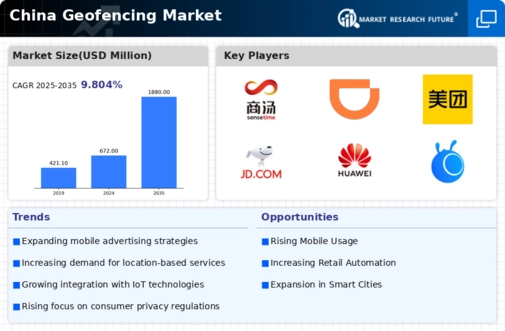Growth of Mobile Device Penetration
The rapid growth of mobile device penetration in China is a significant driver for the geofencing market. With over 1 billion smartphone users in the country, businesses are increasingly recognizing the potential of mobile technology to reach consumers effectively. The widespread use of mobile devices enables companies to implement geofencing strategies that target users based on their real-time location. In 2025, it is estimated that mobile advertising spending in China will exceed $50 billion, highlighting the importance of location-based marketing. As businesses seek to capitalize on this trend, the demand for geofencing solutions is likely to increase. Moreover, the integration of advanced technologies such as 5G is expected to enhance the capabilities of geofencing applications, allowing for more precise targeting and improved user experiences. This growth in mobile device usage is poised to significantly impact the geofencing market in China.
Emergence of Advanced Analytics Tools
The emergence of advanced analytics tools is significantly influencing the geofencing market in China. Businesses are increasingly utilizing data analytics to gain insights into consumer behavior and preferences. Geofencing technology, combined with advanced analytics, enables companies to track customer movements and interactions, providing valuable data for decision-making. In 2025, the analytics market in China is expected to reach $20 billion, indicating a growing reliance on data-driven strategies. This trend allows businesses to optimize their geofencing campaigns, ensuring that marketing efforts are both effective and efficient. As organizations recognize the importance of data in enhancing customer engagement and driving sales, the demand for geofencing solutions that incorporate advanced analytics is likely to rise. Consequently, the integration of analytics tools is expected to propel the growth of the geofencing market in China.
Increased Focus on Customer Experience
The heightened focus on customer experience in China is driving the geofencing market. Companies are increasingly prioritizing personalized interactions to foster customer loyalty and satisfaction. Geofencing technology allows businesses to tailor their marketing efforts based on consumers' locations, providing relevant offers and information at the right time. This approach not only enhances customer engagement but also improves conversion rates. In 2025, it is projected that companies investing in customer experience initiatives will see a return on investment of up to 300%. As organizations strive to differentiate themselves in a competitive landscape, the adoption of geofencing solutions is likely to become more prevalent. By leveraging geofencing to create seamless and personalized experiences, businesses can strengthen their relationships with customers, thereby driving growth in the geofencing market.
Government Support for Smart Technologies
The Chinese government's commitment to advancing smart technologies plays a crucial role in the growth of the geofencing market. Initiatives aimed at promoting digital transformation and smart city development are creating a favorable environment for geofencing solutions. The government has allocated substantial funding, estimated at over $100 billion, to support the integration of smart technologies across various sectors. This investment is likely to enhance infrastructure, enabling businesses to implement geofencing solutions more effectively. Furthermore, as urbanization continues to accelerate, the need for efficient resource management and improved public services becomes increasingly apparent. Geofencing technology can facilitate these objectives by optimizing traffic management and enhancing public safety. Consequently, government support is expected to drive the adoption of geofencing solutions, contributing to the overall expansion of the geofencing market in China.
Rising Demand for Location-Based Services
The increasing demand for location-based services in China is a primary driver for the geofencing market. Businesses are leveraging geofencing technology to enhance customer engagement and improve marketing strategies. In 2025, the market for location-based services is projected to reach approximately $10 billion, indicating a robust growth trajectory. Companies are utilizing geofencing to send targeted promotions and notifications to consumers' mobile devices when they enter specific geographic areas. This trend is particularly evident in sectors such as retail and hospitality, where personalized marketing can significantly influence consumer behavior. As more businesses recognize the potential of geofencing to drive sales and improve customer experiences, the demand for geofencing solutions is expected to rise, thereby propelling the growth of the geofencing market in China.
















